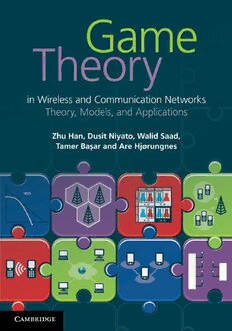Table Of ContentGameTheoryinWirelessandCommunicationNetworks
This unified treatment of game theory focuses on finding state-of-the-art solutions to
issuessurroundingthenextgenerationofwirelessandcommunicationnetworks.Future
networkswillrelyonautonomousanddistributedarchitecturestoimprovetheefficiency
and flexibility of mobile applications, and game theory provides the ideal framework
fordesigningefficientandrobustdistributedalgorithms.Thisbookenablesreadersto
developasolidunderstandingofgametheory,itsapplications,anditsuseasaneffective
toolforaddressingvariousproblemsinwirelesscommunicationandnetworking.
The key results and tools of game theory are covered, as are various real-world
technologies including 3G/4G networks, wireless LANs, sensor networks, cognitive
networks, and Internet networks. The book also covers a wide range of techniques
for modeling, designing, and analyzing communication networks using game theory,
as well as state-of-the-art distributed design techniques. This is an ideal resource for
communicationsengineers,researchers,andgraduateandundergraduatestudents.
Zhu Han is an Assistant Professor of Electrical and Computer Engineering at the
University of Houston. He was awarded his Ph.D. in Electrical Engineering from the
UniversityofMaryland,CollegePark,in2003andworkedfortwoyearsinindustryas
anR&DEngineerforJDSD.
Dusit Niyato is an Assistant Professor in the School of Computer Engineering at the
NanyangTechnologicalUniversity(NTU),Singapore.HereceivedhisPh.D.inElectrical
andComputerEngineeringfromtheUniversityofManitoba,Canada,in2008.
Walid Saad is an Assistant Professor at the Electrical and Computer Engineering
Department at the University of Miami. His research interests include applications
of game theory in wireless networks, small cell networks, cognitive radio, wireless
communicationsystems(UMTS,WiMAX,LTE,etc),andsmartgrids.
TamerBas¸arisaSwanlundChairholderandCASProfessorofElectricalandComputer
EngineeringattheUniversityofIllinoisatUrbana-Champaign.Heisamemberofthe
US NationalAcademy of Engineering, a Fellow of the IEEE and the IFAC, founding
presidentoftheISDG,andcurrentpresidentoftheAACC.
AreHjørungneswasaProfessorintheFacultyofMathematicsandNaturalSciencesat
theUniversityofOslo,Norway.HewasaSeniorMemberoftheIEEEandreceivedhis
Ph.D.fromtheNorwegianUniversityofScienceandTechnologyin2000.
Game Theory in Wireless and
Communication Networks
Theory, Models, and Applications
ZHU HAN
UniversityofHouston
DUSIT NIYATO
NanyangTechnologicalUniversity,Singapore
WALID SAAD
PrincetonUniversity
TAMER BAS¸AR
UniversityofIllinoisatUrbana-Champaign
ARE HJØRUNGNES
UniversityofOslo,Norway
cambridge university press
Cambridge,NewYork,Melbourne,Madrid,CapeTown,
Singapore,SãoPaulo,Delhi,Tokyo,MexicoCity
CambridgeUniversityPress
TheEdinburghBuilding,CambridgeCB28RU,UK
PublishedintheUnitedStatesofAmericabyCambridgeUniversityPress,NewYork
www.cambridge.org
Informationonthistitle:www.cambridge.org/9780521196963
©CambridgeUniversityPress2012
Thispublicationisincopyright.Subjecttostatutoryexception
andtotheprovisionsofrelevantcollectivelicensingagreements,
noreproductionofanypartmaytakeplacewithoutthewritten
permissionofCambridgeUniversityPress.
Firstpublished2012
PrintedintheUnitedKingdomattheUniversityPress,Cambridge
AcatalogrecordforthispublicationisavailablefromtheBritishLibrary
LibraryofCongressCataloginginPublicationData
Gametheoryinwirelessandcommunicationnetworks:theory,models,
andapplications/ZhuHan...[etal.].
p. cm.
Includesbibliographicalreferencesandindex.
ISBN978-0-521-19696-3(hardback)
1. Wirelesscommunicationsystems. 2. Mobilecommunicationsystems. 3. Computer
networks. 4. Telecommunicationsystems. 5. Gametheory. I. Han,Zhu,1974– II. Title.
TK5103.2.G352011
621.38401(cid:2)5193–dc23 2011014906
ISBN978-0-521-19696-3Hardback
CambridgeUniversityPresshasnoresponsibilityforthepersistenceor
accuracyofURLsforexternalorthird-partyinternetwebsitesreferredtoin
thispublication,anddoesnotguaranteethatanycontentonsuchwebsitesis,
orwillremain,accurateorappropriate.
While on a sabbatical at the University of Hawaii, our colleague and co-author,
Dr.AreHjørungnes,wentmissingandpassedawayduringamountainrunonthe
islandofOahu.Wordsfailtoexpressoursadnessandsorrowinlosingourdear
friend.Are,youwillremainforeverengravedinourheartsandmemories,asthe
Vikingwhowasstrongerthanlifeitself.Wewillalwaysrememberyouropenness,
greatspirit,andtechnicalbrilliance.Wewouldliketodedicatethisbooktoyou,as
youreffortsandperseverancewereinstrumentalinthecompletionofthiswork.
Mayyoursoulrestinpeace.
ZH,DN,WS,TB
Tomydaughter,MelodyHan—ZhuHan
Tomyfamily—DusitNiyato
TomywifeMaryandmysonKarim—WalidSaad
Tomywife,Tangül—TamerBas¸ar
Tomygrandmother,Margit—AreHjørungnes
Contents
Preface page xv
1 Introduction 1
1.1 Briefintroductiontothehistoryofgametheory 1
1.2 Gametheoryinwirelessandcommunicationnetworks 3
1.3 Organizationandtargetedaudience 4
1.3.1 Timelinessofthebook 6
1.3.2 Outlineofthebook 9
2 Wirelessnetworks:anintroduction 14
2.1 Wirelesschannelmodels 15
2.1.1 Radiopropagation 15
2.1.2 Interferencechannel 20
2.2 Categorizationofwirelessnetworks 21
2.2.1 3Gcellularnetworksandbeyond 21
2.2.2 WiMAXnetworks 25
2.2.3 WiFinetworks 27
2.2.4 Wirelesspersonalareanetworks 31
2.2.5 Wirelessadhocnetworks 37
2.2.6 Wirelesssensornetworks 40
2.3 Advancedwirelesstechnology 45
2.3.1 OFDMtechnology 45
2.3.2 Multiple-antennasystems 47
2.3.3 Cognitiveradio 49
PartI Fundamentalsofgametheory
3 Non-cooperativegames 55
3.1 Non-cooperativegames:preliminaries 55
3.1.1 Introduction 55
3.1.2 Basicsofnon-cooperativegames 56
viii Contents
3.2 Non-cooperativegamesinstrategicform 58
3.2.1 Matrixgames 58
3.2.2 Dominatingstrategies 61
3.2.3 Nashequilibrium 63
3.2.4 Staticcontinuous-kernelgames 65
3.2.5 Mixedstrategies 69
3.2.6 Efficiencyandequilibriumselection 72
3.3 Dynamicnon-cooperativegames 74
3.3.1 Non-cooperativegamesinextensiveform 74
3.3.2 Repeatedgames 80
3.3.3 Stochasticgames 84
3.4 Specialclassesofnon-cooperativegames 85
3.4.1 Potentialgames 85
3.4.2 Stackelberggames 88
3.4.3 Correlatedequilibrium 91
3.4.4 Supermodulargames 94
3.4.5 Wardropequilibrium 96
3.5 Summary 100
4 Bayesiangames 101
4.1 OverviewofBayesiangames 101
4.1.1 Simpleexample 101
4.1.2 StaticBayesiangame 102
4.1.3 Bayesiandynamicgamesinextensiveform 104
4.1.4 Cournotduopolymodelwithincompleteinformation 105
4.1.5 Auctionwithincompleteinformation 107
4.2 Applicationsinwirelesscommunicationsandnetworking 109
4.2.1 Packet-forwardinggame 109
4.2.2 K-playerBayesianwater-fillinggame 112
4.2.3 Channel-accessgame 116
4.2.4 Bandwidth-auctiongame 119
4.2.5 Bandwidth-allocationgame 121
4.3 Summary 122
5 Differentialgames 124
5.1 Optimal-controltheory 125
5.1.1 Dynamicprogramming 125
5.1.2 Themaximumprinciple 126
5.2 Differentialgames 128
5.2.1 Mainingredientsandgeneralresults 128
5.2.2 Stackelbergdifferentialgame 130
5.3 Applicationsofdifferentialgamesinwirelesscommunications
andnetworking 136
5.4 Summary 137
Contents ix
6 Evolutionarygames 138
6.1 Theevolutionaryprocess 139
6.1.1 Evolutionarilystablestrategies 139
6.1.2 Replicatordynamics 141
6.1.3 Theevolutionarygameandreinforcementlearning 143
6.2 Applicationsofevolutionarygamesinwirelesscommunicationsand
networking 144
6.2.1 Congestioncontrol 144
6.2.2 EvolutionarygamefortheAlohaprotocol 146
6.2.3 EvolutionarygameforWCDMAaccess 148
6.2.4 Routing-potentialgame 149
6.2.5 Cooperativesensingincognitiveradio 151
6.2.6 TCPthroughputadaptation 154
6.2.7 Userchurningbehavior 158
6.2.8 Dynamicbandwidthallocationwithevolutionarynetwork
selection 163
6.3 Summary 170
7 Cooperativegames 171
7.1 Bargainingtheory 171
7.1.1 Introduction 171
7.1.2 TheNashbargainingsolution 172
7.1.3 Sampleapplicationsinwirelessandcommunicationnetworks 178
7.2 Coalitionalgametheory:basics 185
7.2.1 Introduction 185
7.2.2 Coalitional-gametheory:preliminaries 185
7.3 ClassI:canonicalcoalitionalgames 189
7.3.1 Mainpropertiesofcanonicalcoalitionalgames 189
7.3.2 Thecoreasasolutionforcanonicalcoalitionalgames 190
7.3.3 TheShapleyvalue 195
7.3.4 Thenucleolus 196
7.3.5 Sampleapplicationsinwirelessandcommunicationnetworks 198
7.4 ClassII:coalition-formationgames 203
7.4.1 Mainpropertiesofcoalition-formationgames 203
7.4.2 Impactofacoalitionalstructureonsolutionconceptsfor
canonicalcoalitionalgames 203
7.4.3 Dynamiccoalition-formationalgorithms 205
7.4.4 Sampleapplicationsinwirelessandcommunicationnetworks 209
7.5 ClassIII:coalitionalgraphgames 215
7.5.1 Mainpropertiesofcoalitionalgraphgames 215
7.5.2 Coalitionalgraphgamesandnetwork-formationgames 216
7.5.3 Sampleapplicationsinwirelessandcommunicationnetworks 219
7.6 Summary 220
x Contents
8 Auctiontheoryandmechanismdesign 221
8.1 Introductionandauctionbasics 222
8.2 Mechanismdesign 226
8.2.1 Equilibriumconcepts 226
8.2.2 Participationandincentivecompatibility 227
8.2.3 Revelationprinciple 228
8.2.4 Budgetbalanceandefficiency 228
8.2.5 Grovesmechanism 229
8.2.6 Impossibilityandpossibility 229
8.3 Specialauctions 230
8.3.1 VCGauction 230
8.3.2 Shareauction 232
8.3.3 Doubleauction 233
8.4 Examplesofcommunicationapplications 235
8.4.1 Cognitiveradio 236
8.4.2 Physical-layersecurity 248
8.5 Summary 251
PartII Applicationsofgametheoryincommunicationsandnetworking
9 Cellularandbroadbandwirelessaccessnetworks 255
9.1 UplinkpowercontrolinCDMAnetworks 257
9.1.1 Single-cellCDMAnetworks 258
9.1.2 Multi-cellwirelessCDMAnetworks 263
9.2 Resourceallocationinsingle-cellOFDMAnetworks 269
9.2.1 OFDMAresource-allocationmodel 270
9.2.2 Nashbargainingsolutionforsubcarrierallocation 272
9.2.3 AlgorithmsforreachingtheNashbargainingsolution 274
9.3 Powerallocationinfemtocellnetworks 279
9.3.1 FemtocellpowercontrolasaStackelberggame 280
9.3.2 Multi-leadermulti-followerStackelbergequilibrium 284
9.3.3 AlgorithmforreachingtheStackelbergequilibrium 286
9.4 IEEE802.16broadbandwirelessaccessnetworks 287
9.4.1 Resourceallocationandadmissioncontrol 287
9.4.2 Relay-stationdeploymentinIEEE802.16j 299
9.5 Networkselectioninmulti-technologywirelessnetworks 307
9.5.1 Networkselectionasanon-cooperativegame 309
9.5.2 Networkselectionwithincompleteinformation 311
9.6 Summary 320
10 Wirelesslocalareanetworks 321
10.1 MACprotocoldesign 322
10.1.1 Staticgame 323

